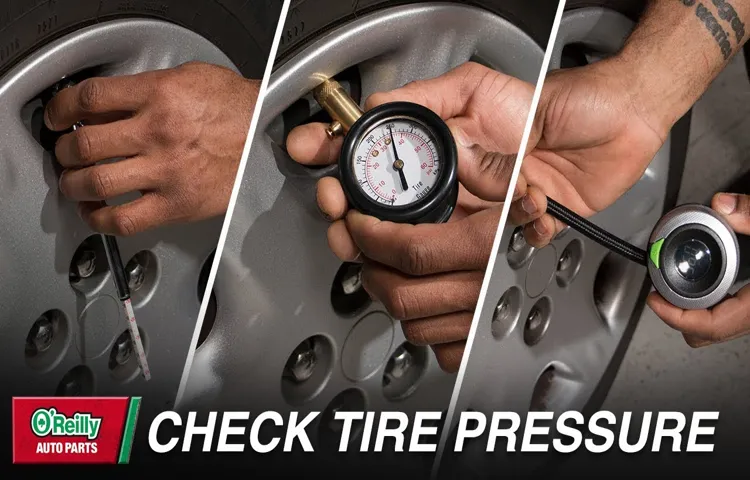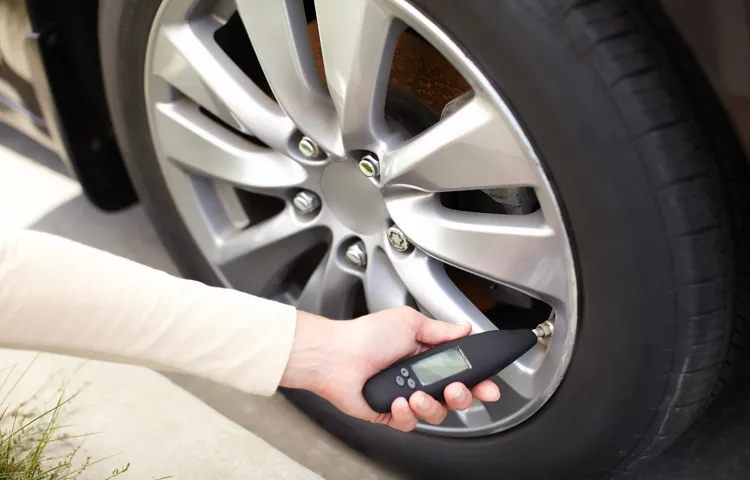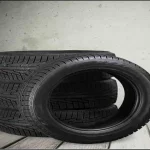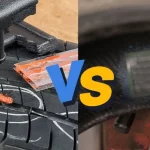Have you ever wondered how often you should check your spare tire pressure? It’s a question that often gets overlooked, yet it’s an essential part of maintaining your car’s safety. After all, a flat spare tire is no help in an emergency. Checking your spare tire pressure should be included in your regular car maintenance routine.
A good rule of thumb is to check it every six months. However, if you’ve recently used your spare tire or driven in extreme temperatures or rough terrain, it’s essential to check it more frequently. Think of your spare tire as a safety net.
You hope you never have to use it, but if an emergency arises, you’ll be grateful it’s there. That’s why it’s important to make sure it’s always ready to go when you need it. So, take a few minutes to check your spare tire pressure and rest easy knowing you’re prepared for the unexpected.
Table of Contents
Why It’s Important to Check Your Spare Tire Pressure
It’s easy to forget about your spare tire until you need it. But, it’s important to check the spare tire pressure regularly, just like you do with your other tires. Experts recommend checking the spare tire pressure at least once a month, and before you go on a long road trip.
A flat spare tire can leave you stranded and delay your plans, so it’s better to be safe than sorry. In fact, a properly inflated spare tire can make all the difference when it comes to your safety on the road. If your spare tire is underinflated, it can affect your car’s handling and stability, particularly if you’re driving at high speeds.
So, make sure you check your spare tire pressure regularly, and if the pressure is low, inflate it to the recommended level. That way, you can hit the road with peace of mind knowing that you’re prepared for any unexpected situations that may arise.
Prevent Unexpected Emergencies on the Road
When it comes to hitting the road, it’s important to be prepared for the unexpected. One way to do this is to check the pressure of your spare tire. Many people forget to do this and end up in a stressful situation when they have a flat tire and their spare is also deflated.
Checking the pressure of your spare tire is a quick and easy task that can save you from a roadside emergency. Make sure to use a tire pressure gauge to get an accurate reading and inflate the tire to the recommended pressure level. It’s also important to check the condition of your spare tire to ensure it is in good shape and has sufficient tread depth.
This simple precaution can give you peace of mind while on the road and prevent you from being stranded in an inconvenient or potentially dangerous situation. Don’t forget to give your spare tire the attention it deserves and stay prepared for whatever the road may bring.

Ensure Safety While Driving
When it comes to driving safety, checking your spare tire pressure may seem like small potatoes. However, it’s an incredibly important step in ensuring that you and your passengers stay safe on the road. In the event of a flat tire, having a properly inflated spare can mean the difference between a minor inconvenience and a dangerous situation.
Low tire pressure can affect your car’s handling, making it more difficult to control in emergency situations. Additionally, a spare tire that’s been sitting in your trunk for years without being checked can become damaged and unusable. By taking a few minutes to check your spare tire pressure regularly, you can rest easy knowing that you’re prepared for any unexpected bumps in the road.
So next time you give your car a once-over, don’t forget to give your spare tire a little love, too.
When Should You Check Your Spare Tire Pressure
Spare tire pressure is often overlooked when it comes to regular vehicle maintenance. Many assume that checking their regular tire pressure is sufficient, but it’s important to also check the spare tire pressure in case of emergency. So, how often should you check your spare tire pressure? Experts recommend checking it at the same time as your regular tire pressure, which is usually every month or before long trips.
It’s also important to ensure that your spare tire is free of any tears, bulges, or punctures that could render it unusable in an emergency. Remember, a properly inflated and well-maintained spare tire can be a lifesaver on the road. So, don’t neglect it and make sure to add it to your regular maintenance routine.
Monthly Maintenance Checks
Monthly Maintenance Checks When it comes to ensuring your vehicle is ready to hit the road at any given moment, conducting regular monthly maintenance checks is crucial. One often overlooked aspect of these checks is the spare tire pressure. It’s important to ensure that your spare tire is at the proper inflation level, as an underinflated spare tire can be just as dangerous as a flat tire.
It’s recommended to check the pressure of your spare tire at least once a month, along with the rest of your tires. As a general rule of thumb, the tire pressure should be around 30-35 PSI, but it’s important to refer to your vehicle’s manual for specific recommendations. By making this a consistent part of your monthly maintenance routine, you’ll have peace of mind knowing that your spare tire is ready to go if the unexpected happens on the road.
Before Long Road Trips
Before embarking on a long road trip, it’s important to check the pressure of your spare tire. Most people don’t realize that spare tires can also lose air over time, just like regular tires. The last thing you want is to be stranded in the middle of nowhere with a flat tire and a spare that’s also flat.
So when should you check your spare tire pressure? Ideally, you should do this at least once every six months, or before any long journey. It’s also a good idea to inspect your spare tire to make sure it’s in good condition, has enough tread, and doesn’t appear worn or damaged. By checking your spare tire pressure regularly, you can ensure your safety and avoid any unexpected mishaps on the road.
Main Keyword: Spare Tire Pressure.
After Using the Spare Tire
Checking the pressure of your spare tire is not something that we often think about until it is too late. It is important to understand that spare tires can lose pressure over time, especially if they’ve been in storage and unused for extended periods. As such, it is essential to check the pressure of your spare tire regularly to ensure that it is still capable of providing the necessary support in cases of a tire blowout or puncture.
A good time to check your spare tire pressure is alongside your regular tire maintenance schedule. Checking the pressure of your main tires every month or so is standard procedure, and you should take advantage of this time to also check on your spare tire. The ideal spare tire pressure can vary depending on the vehicle make and model, so be sure to check your vehicle’s owner’s manual for guidance.
Regularly checking your spare tire pressure can prevent unforeseen consequences and ensure you are prepared for any unexpected events.
How to Check Your Spare Tire Pressure
It’s essential to check your vehicle’s spare tire pressure regularly to ensure that it’s ready to use in case of a flat tire. The frequency at which you should check your spare tire pressure depends on how often you use your vehicle and the weather conditions. Generally, it’s recommended to check your spare tire pressure at least once a month.
However, if you’re driving in extreme temperatures, your spare tire pressure can fluctuate more frequently, and you should check it more often. To check your spare tire pressure, simply remove the tire’s valve cap and use a tire pressure gauge to measure the pressure. The recommended pressure for your spare tire can typically be found in your vehicle’s manual or on the tire’s sidewall.
If the pressure is too low, inflate the tire to the recommended pressure using an air compressor or at a gas station. Remember to check the spare tire’s pressure before taking a road trip or a long-distance drive to avoid any inconvenience on the road.
Gather Necessary Tools
To check your spare tire pressure, you need to gather a few necessary tools. First, you’ll need to locate the spare tire in your vehicle and identify the recommended pressure level. You can find this information in your owner’s manual.
Then, you’ll need a tire pressure gauge to check the spare tire’s pressure. These gauges can be purchased at most automotive stores and are easy to use. Simply remove the tire valve cap, press the gauge onto the valve stem, and read the pressure reading.
If the pressure is too low, use an air compressor or tire inflator to add air until it reaches the recommended level. Once you have checked and adjusted the pressure, don’t forget to replace the valve cap and stow the spare tire back in its designated location. It’s important to have a properly inflated spare tire in case of an emergency, so it’s a good idea to check it periodically.
Remove the Spare Tire
Removing your spare tire and checking its pressure is an important step in maintaining your vehicle’s overall health and safety. Most importantly, before you embark on a long road trip or go for a spin around the block, always ensure that your spare tire is fully inflated. To check the spare tire pressure, remove it from the trunk and use a tire gauge to measure the pressure.
The recommended pressure for most spare tires is between 60 and 80 PSI. Keep in mind that this pressure may vary depending on the make and model of your vehicle. If you find the tire pressure to be low, inflate it immediately and keep tabs on it over time to ensure that it stays at the recommended level.
Don’t overlook the importance of checking your spare tire pressure, as it could mean the difference between a smooth ride and a headache on the side of the road.
Check the Tire Pressure
Checking your spare tire pressure is a crucial aspect of maintaining your vehicle’s safety. When it comes to spare tires, we oftentimes forget about checking their pressure until we actually need it. However, it is essential to ensure the spare tire has the appropriate pressure to perform effectively in case of an emergency.
To check the spare tire pressure, locate the valve stem and use a tire pressure gauge to measure the pressure. The recommended pressure is typically listed in your vehicle manual or on a sticker located on the driver’s side door jamb. Remember to check your spare tire pressure at least once a month and before long trips, as low tire pressure can lead to decreased fuel efficiency and compromised safety on the road.
Taking a few minutes to regularly check your spare tire pressure could save you from a potentially hazardous situation.
Inflate or Deflate If Needed
When was the last time you checked the pressure of your spare tire? Most people tend to forget about it until they have a flat and need to use it. But did you know that your spare tire can also lose pressure over time, just like the tires you are currently using on your car? It’s important to check your spare tire pressure regularly to ensure it’s ready to use when you need it most. To check the pressure of your spare tire, you’ll need a tire pressure gauge.
Simply remove the valve cap from the tire, press the gauge onto the valve stem, and read the pressure. If the pressure is too low, inflate it to the recommended pressure listed in your car’s manual. On the other hand, if the pressure is too high, you’ll need to deflate it to the recommended pressure.
This simple step can save you a lot of trouble when you get a flat tire on the road. Remember, always check your spare tire pressure at least once a month and before long trips.
Conclusion
As the great philosopher Aristotle once said, “moderation in all things.” This sentiment rings true when it comes to checking your spare tire pressure. While it’s important to keep it properly inflated for those unexpected flat tire moments, it’s not something that needs to be checked every day.
Just like with most things in life, checking your spare tire pressure every few months is a happy medium that will ensure it’s ready to go when you need it most.”
FAQs
Why is it important to check the spare tire pressure?
It is important to check the spare tire pressure because an underinflated spare tire can become a safety hazard, as it may not perform well in an emergency situation.
How often should I check the spare tire pressure?
It is recommended to check the spare tire pressure at least once every six months or before embarking on a long journey, whichever comes first.
Can I check the spare tire pressure myself or do I need to take it to a mechanic?
You can check the spare tire pressure yourself using a tire pressure gauge, although some mechanics may offer to check it for you during a routine maintenance check.
What is the ideal pressure for a spare tire?
The ideal pressure for a spare tire varies depending on the make and model of your vehicle. Check your vehicle’s manual or the spare tire itself for the recommended pressure.
What should I do if the spare tire pressure is low?
If the spare tire pressure is low, add air to the tire until it meets the recommended pressure. If you are unsure how to properly inflate a tire, consult your vehicle’s manual or take it to a professional.
Do I need to replace the spare tire if it is underinflated?
If the spare tire is underinflated but otherwise in good condition, you may be able to simply inflate it to the recommended pressure and continue to use it. However, if the tire is damaged or has worn treads, it may need to be replaced.
What other maintenance should I perform on my spare tire?
In addition to checking the pressure regularly, you should also inspect the spare tire for signs of wear, such as cracks or cuts in the treads. If the tire is damaged, it should be replaced immediately.



